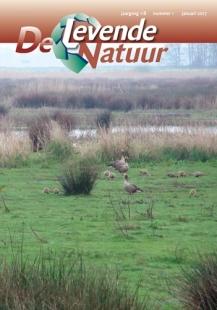De Levende Natuur nummer 1 van 2017 (English summary)
Afbeelding

Nature reserve De Onlanden, five years after the flooding
W.H.M. van Boekel, R. Blaauw, J. de Bruin, R. Oosterhuis & B. Zoer
In January 2012, nature reserve De Onlanden, located in the northern part of The Netherlands, changed suddenly from a meadows and hayland biotope on peat soil into a largescale marshland biotope and water containment area. Water levels throughout the reserve were raised by 30 to 70 cm, and are now fluctuating largely over the year, depending on the amount of rainfall in the upstream area of the two small rivers that feed the reserve. Newly dug channels connect these rivers with the lake (Leekstermeer) in the reserve, thereby creating one large, interconnected water system.
In the largest part of the reserve, management of the vegetation by mowing or grazing was no longer possible after the transformation, due to the high water levels. Here the vegetation developed freely. At most locations the vegetation quickly became much higher and more dense. In the parts of the reserve on higher ground, or where water levels were kept under mowing field, mowing and/or grazing could be continued after 2012. Here, plant communities often had to adapt to the higher water levels by moving along the gradients.
Breeding birds quickly reacted to the biotope change. Marshland birds immediately became dominant in the new situation. Some breeding birds of meadows, like Lapwing and Redshanks, also profited from the higher water levels, whereas other species, like Black-tailed Godwit and Skylark continued to decrease in number. In the winter period, large numbers of geese and ducks found new resting places in the many areas of shallow, open water in De Onlanden.
Five years after the transformation of De Onlanden five to ten Otters are present in the reserve, and at least four litters have been produced. Numbers of Water shrew have increased rapidly, making it one of the most abundant small mammal species in the reserve. Common vole, that was dominant before the transformation, has disappeared almost completely, even in the driest parts of the reserve.
Many other animal species (amphibians, dragonflies, grasshoppers, fish) have profited from the transformation of De Onlanden. The increase of Water soldier at existing and new locations resulted in an increase of the numbers of the very rare Green hawkers in De Onlanden.
‘Rewilding’, landscape and identity
M. Drenthen
Rewilding is part of a broader cultural trend to defend the value of wildness against an overly humanized world. Therefore, rewilding in cultural heritage landscapes gives rise to conflicts between different views of landscapes and self that cannot be easily reconciled. Yet, rewilding also presents nature conservationists with an opportunity to strengthen the moral base of conservation as a social movement.
Giving a voice to citizen scientists
R.J.G. van den Born, W. Ganzevoort, S. Turnhout & H. de Vries
Citizen scientists are crucial for the collection of biodiversity data in The Netherlands. However, there is little research into the socio-demographic profile of these volunteer recorders, their approach to nature recording, their motivations, and their views on data sharing. This article presents the results of a large-scale survey (N = 2193) among Dutch volunteer recorders which explored these questions. We also discuss the implications of our findings for continued engagement of citizen scientists in nature recording.

